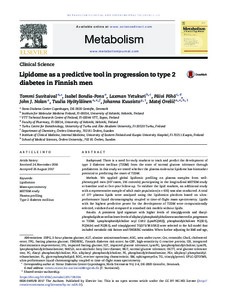Lipidome as a predictive tool in progression to type 2 diabetes in Finnish men
Johanna Kuusisto; Tommi Suvitaival; Matej Orešič; John J. Nolan; Tuulia Hyötyläinen; Laxman Yetukuri; Isabel Bondia-Pons; Päivi Pöhö
Lipidome as a predictive tool in progression to type 2 diabetes in Finnish men
Johanna Kuusisto
Tommi Suvitaival
Matej Orešič
John J. Nolan
Tuulia Hyötyläinen
Laxman Yetukuri
Isabel Bondia-Pons
Päivi Pöhö
W B SAUNDERS CO-ELSEVIER INC
Julkaisun pysyvä osoite on:
https://urn.fi/URN:NBN:fi-fe2021042718474
https://urn.fi/URN:NBN:fi-fe2021042718474
Tiivistelmä
Background. There is a need for early markers to track and predict the development of type 2 diabetes mellitus (T2DM) from the state of normal glucose tolerance through prediabetes. In this study we tested whether the plasma molecular lipidome has biomarker potential to predicting the onset of T2DM.Methods. We applied global lipidomic profiling on plasma samples from well-phenotyped men (107 cases, 216 controls) participating in the longitudinal METSIM study at baseline and at five-year follow-up. To validate the lipid markers, an additional study with a representative sample of adult male population (n = 631) was also conducted. A total of 277 plasma lipids were analyzed using the lipidomics platform based on ultra performance liquid chromatography coupled to time-of-flight mass spectrometry. Lipids with the highest predictive power for the development of T2DM were computationally selected, validated and compared to standard risk models without lipids.Results. A persistent lipid signature with higher levels of triacylglycerols and diacyl-phospholipids as well as lowerlevels of alkylacyl phosphatidylcholines was observed in progressors to T2DM. Lysophosphatidylcholine acyl C18:2 (LysoPC(18:2)), phosphatidylcholines PC(32:1), PC(34:2e) and PC(36:1), and triacylglycerol TG(17:1/18:1/18:2) were selected to the full model that included metabolic risk factors and FINDRISC variables. When further adjusting for BM and age, these lipids had respective odds ratios of 0.32, 2.4, 0.50, 2.2 and 0.31 (all p < 0.05) for progression to T2DM. The independently-validated predictive power improved in all pairwise comparisons between the lipid model and the respective standard risk model without the lipids (integrated discrimination improvement IDI > 0; p < 0.05). Notably, the lipid models remained predictive of the development of T2DM in the fasting plasma glucose-matched subset of the validation study.Conclusion. This study indicates that a lipid signature characteristic of T2DM is present years before the diagnosis and improves prediction of progression to T2DM. Molecular lipid biomarkers were shown to have predictive power also in a high-risk group, where standard risk factors are not helpful at distinguishing progressors from non-progressors.
Kokoelmat
- Rinnakkaistallenteet [19207]
